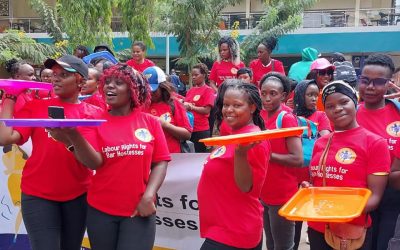Bar Hostess Empowerment & Support Programme (BHESP) has trained 35 female sex workers as peer educators to spread information to their contemporaries on advocating for safe sex.
The 5-day training certified by National AIDS and STI’s Control Programme (NASCOP) was held at BHESP’s Kariobangi Wellness Centre and peer educators were trained on HIV prevention, behavior change communication, sexual health, and human rights in order to guide their peers on behavior change.
According to NASCOP, peer education is a key behavioral component aimed at disseminating behavioral messages designed to encourage people to reduce behaviors that increase the risk of HIV and increase protective behaviors.
“In the training, I have learned so many things that I didn’t know. I had never used a female condom but now I have information on how to use it,” said Irene.
Irene, 26, added that she had gained skills in behavior change communication and was now in a better position to conduct sessions with her peers to improve knowledge, skills, and attitudes that reduce the risk of acquiring or transmitting HIV.
“At least now I have information and I am going to change lives out there. I am going to pass information to my colleagues about protecting themselves,” said Irene who operates in Nairobi pipeline area.
Echoing Irene’s sentiment, Saumu, 30, said the training was knowledgeable and informative as she had gained various skills and would now act as a role model to other female sex workers by giving them information about risk reduction.
“I will inform them about their rights as sex workers. I will ensure I have passed the information to sex workers at my hotspot as many of them are very ignorant,” she said.
Another participant Jacky noted that after the training and especially the negotiation skills session she was now in a better position to convince a client to wear a condom.
“I have learned about how to avoid risks like being raped and violent clients. Now I am well equipped with knowledge which I will share with my peers at our hotspot,” Jacky said.
According to NASCOP’s facilitator Maria Mensah, peer education and outreach programs have indeed been identified as effective ways to increase access to prevention services.
“Sex worker peer educators belong to the sex workers community and share socio-demographic and risk behavior characteristics with other sex workers. They are recognized as leaders and models by their peers. They initiate and maintain contact with sex workers through small group discussions or one-on-one talks,” Mensah explained.
She added that peer educators provide accurate sexual and reproductive health information and they aim to change attitudes and beliefs that hinder risk reduction and encourage peers to adopt safe sex practices.
“A literature review of the evidence of effective peer educator programs found that peer education and outreach programs require a value based approach including respect for sex workers as people and sex work as a means of livelihood, reliance on their capabilities and recognition of their rights.”
“The level of success of peer education and outreach programs depend on the careful selection of peer leaders and the quality of the training, as well as the management of the programs,” Mensah observed.
BHESP recognizes peer education and outreach as key components of a comprehensive HIV prevention program and it has become a popular approach for HIV prevention programming for most-at-risk populations in Kenya.
“The peer educators are the ones in a better position to reach sex workers as they have physical access to intended sex workers in their natural settings without being conspicuous,” said BHESP’s Assistant Project Officer Rose Syotini while expounding more on the importance of peer education as strategy to reach sex workers.
Syotini added that when working with hard-to-reach populations such as sex workers physical access to such populations can be problematic but peer educators have access to them in order to supply them with condoms, lubricants, and IEC materials.
“It’s easier to use peer educators as they are well known and have inside knowledge of different hotspots. They make strong role models for helping in the implementation of HIV-preventive behavior,” she concluded.




